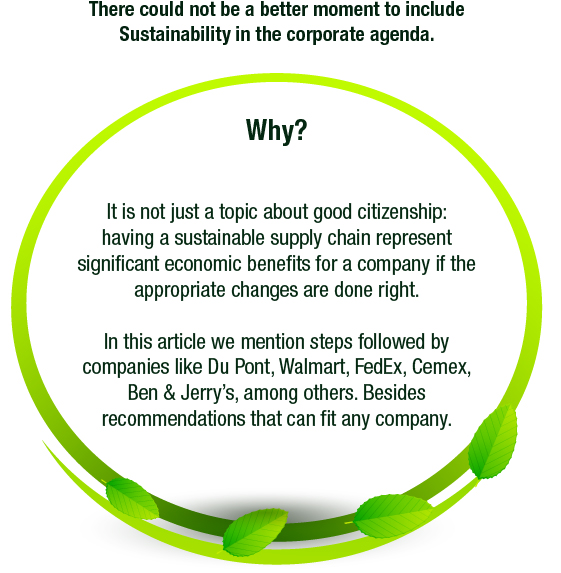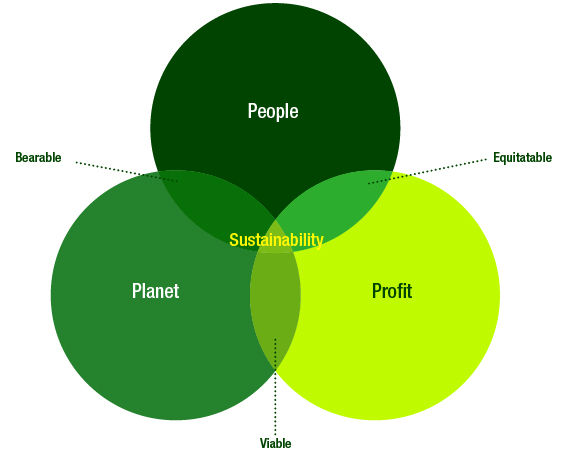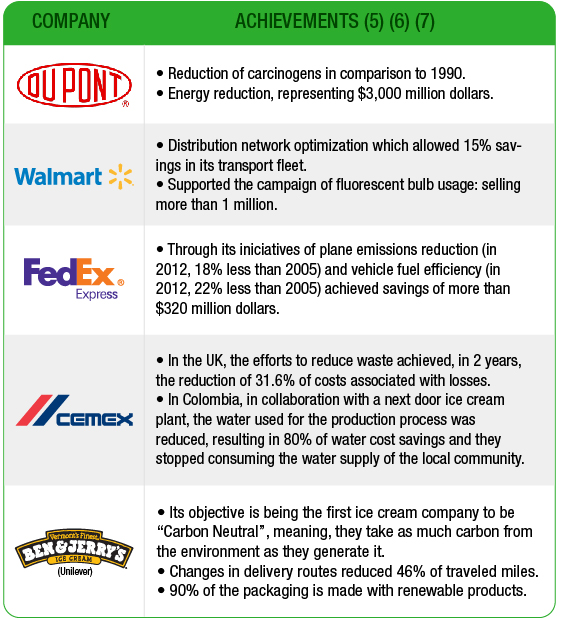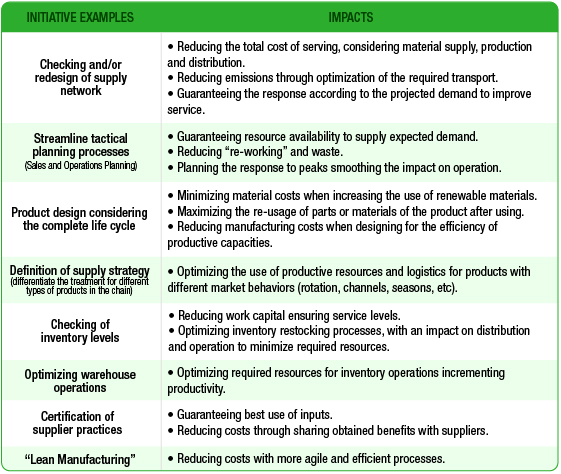How can we include sustainability in the company’s agenda? This is the perfect moment to answer that question.
We have lost synchrony with natural processes and systems; material consumption and our influence on the environment’s natural balance is beyond excessive and harmful to life on the planet. The carbon level is going over the ruff and the average temperature on our every day is widely different from when we were children. Understanding our own contribution, planning and adjusting it so we can be aligned to the environment has become more relevant in the collective awareness. We can illustrate our situation using a famous Chinese proverb: “If we don’t change our way, it is very likely we’ll end up where we are heading”. It is that simple.
Taking into consideration that we have cause this problems with each of our small contributions; the solution is similar: everybody and little by little. What can we improve? It is really easy and we can summarize it in 3 simple steps that must of us have heard of:
- Reduce: Being more efficient
- Reuse: Finding other ways of using materials and products during their life cycles
- Recycling: When such material or product has been used, try to recover as much as it is possible from it and start all over again.
Sustainability: basis and concepts
The concept of Sustainability was first mentioned in the UN report: “Our Future” (1), in which Sustainable Development was defined as: “The development that satisfies present necessities without compromising future generations’ ability to satisfy their own”.
As well, the three pillars of sustainability were defined: Economic Growth (Profitability); Environmental Protection (Planet); and Social Equality (People).
Graphic 1 shows “The Triple Bottom Line”, how the conjoint of the three pillars are called, and their description:
Surely, we are all familiar with the economic aspect of a business, which is the fundamental element that guarantees the survival of a company; but, short-term profitability is just a small slice of the cake. The value that a company generates (or eliminates) for society on the long run, meaning, “doing the right thing”, also has to be taken into consideration. A focus that considerates the natural environment and the society in which a company operates and the impact it has on it, completes its total contribution to society. There are already companies that have done so, such as Ford, included in its business values by calling its relationship with clients, employees and community, their “license to operate” (2).
Adding sustainability to the corporate agenda represents attractive opportunities that we will explain throughout this article. But just as the saying goes: sometimes doing nothing is the worst you can do, the lack of action in this topic brings considerable risks to companies, and some of them are:
- Brand damage and the loss of customers’ trust because of an event that could have been prevented.
- Examples: Non-governmental call outs due to wrong processes in the chain, providers with questionable (or plain bad) practices, findings of toxic ingredients or pollutants in the products, accidents in the chain that impact entire ecosystems, among other.
- Legislation. Lately, there has been a deeper common understanding of the problem, which even has politicians and governments turning their heads towards this topic, including it in legislative discussions, but it is not necessary to wait for laws to tell us what is right or not, if we already know beforehand.
In other words, if we are already working hard to build a positive image in the mind of our clients and/or consumers, why are we risking the loss of millions just because we believe we are saving a few bucks?
The Supply chains that start sooner rather than later their path towards sustainability will see the benefits in the (not so far away) future, when regulations become more strict with topics regarding carbon emissions; the ones that chose to just watch it happen are in risk of fines or rushed and forced investment. The effects of transition towards a sustainable culture that has been setting ground in the government can already be seen in some countries, like China, for example.

In august, the Asian country announced an investment of $275 billion dollars in the next 5 years to help clean pollution from the air in most parts of Beijing and its surrounding cities. It is important to mention that China is the biggest carbon emitter worldwide; this is the main greenhouse gas that causes global warming. When two of the main oil companies of the country, China National Petroleum and China Petrochemical Corporation, failed to comply with the CO2 reduction plan, they were penalized suspending all of their refinery projects. (3)
The Sustainable Supply Chain is particularly relevant when we recognize that in its processes we can find the direct responsibles of material, energy and water usage, as well as important pollution generators. It is not without fundament that, in literature as well as in collective understanding, it is often cited that: “The most common enemies of the environment are manufacturing and production operations” (4). Does it ring a bell?
Sustainable Supply Chain: The new value generator
If the supply chain seeks to give the best service at the lowest possible cost; adding “sustainable” as last name, means doing that while minimizing the environmental impact and ensuring a positive social impact, at the same time.
Besides being the contribution of a company to the solution, a sustainable supply chain is also good for business. Why? Because a sustainable supply chain:
- Consumes fuel efficiently
- Optimizes productive and logistic assets (like warehouses, transport, inventory, etc)
- Designs it products considering the complete life cycle and its impact on the environment
- Establishes commitments with it commercial partners to achieve common goals of waste and cost reduction, besides improvement in service and quality.
These examples have a positive impact on business profitability, turning the Supple Chain into a value generator, and it also sends a very powerful message to clients and society, as a whole.
Where are the benefits of the Sustainable Supply Chain?
In addition to the obvious input to the environment, a Sustainable Supply Chain has real benefits with a financial impact. These come mainly from the key concept of sustainability: to reduce inefficiency and waste, which applies throughout productive and logistic processes. A more efficient product distribution is one of the biggest benefit sources, besides less material consumption and lower unitary production costs. The focus towards the total life cycle of the product, from its design to the fabrication process, allows incorporating recycled material or reusing components at the ends of its useful life, hence reducing input costs.
There are also intangible benefits like differentiation in consumer minds and Brand strengthening by having products oriented to the environment. Another benefit is the administration and risk reduction associated with the possibility of a new legislation on this topic. Nobody wants to be in the same shoes of those Chinese oil companies.
This reality makes refocusing the supply chain towards sustainability, a business decision that has benefits and a real return on investment, not just a clean conscious and good citizenship.
Table 2 shows several examples of such benefits:
The path to a Sustainable Supply Chain
Now that we already have the executive and board members of the company in the sustainability boat, considering it as an element relevant to the business strategy, how do we start to implement it successfully in the Supply Chain? We drew a series of steps to help you out.
When we have the first step, we can consider that we have covered an important part of the journey: Executive Sponsorship. If we did not have it, decentralized and non-integrated initiatives would be generated, diminishing the effort effectivity, which wouldn’t even be aimed in the same direction. And that would be the “best case scenario”. To avoid being in this situation, it is necessary to have the support of the central office aligned to the global business strategy, in a way that provides the necessary resources for the path in front of us.
The next immediate step is the creation of a strategy that will lead us to sustainability is the route traced for that boat that we got on as an organization. The exercise is just like any other to form a strategy:
1) Defining the strategic lineament – In the case of s sustainable supply chain, that means:
- Managing the carbon foot print, meaning, understanding the origin of our emissions, the options to reduce them and their measurement.
- Working with human organizations around the business: suppliers, clients, communities, internal human capital.
- Including sustainability ideas in the processes of value creating in the company. For example: in consumer goods, product design that maximizes recycling; in construction, designing elements that comply with international certifications – LEED -; in retail, awarding suppliers with sustainability certifications, etc.
2) Defining goals to achieve. This implicates being clear of indicators that will be included, measuring the current base on which we will see improvements, the levels of key indicators that we are trying to reach and the time horizon.
3) The definition and prioritization of change initiatives that will transform the strategy into actions and that will generate impact on the Supply Chain.
The next table has some initiative examples that impact on the economic as well as in the environmental and social aspects:
Just like the business strategy, the definitions is just the initial step, the real impact on the day by day needs continuous tracking of the implemented strategy until the highest level and the quality of resource assigning (technology to gather information, personnel with the measurement responsibility, interpreting and communicating results, budgets for required capital for initiatives, external needed support, etc).
Like in any other business area that we are trying to improve, the actions required to have a Sustainable Supply Chain start off from indicators that help us measure them. To build them, the first step is identifying which are the elements in our supply chain that are under our control and have a higher impact on the environment, or in other words, contribute more in the carbon footprint of the company. We can consider 4 general categories: Energy Consumption, Water Consumption, Material Consumption and Waste Generation. Some examples are: transport, production, packaging, raw material, among other, that gives us indicator like: fossil fuel consumption, waste water liters, production efficiency, percentage of biodegradable materials in packaging, etc.
It is important to consider that these indicators are usually something new to the company, so the initial effort of information gathering has to be planned with the according resources.
From this understanding and the defined strategy, we set goals that impact in the emission reduction in each category and associate initiatives so that we can achieve such goals and, this way, we can reach our final destination: an authentic Sustainable Supply Chain. The execution of the initiatives is only possible when in a company, sustainability turns into a value lived day by day and decision by decision.
The ideal objective is reaching a concept known as “net zero footprint” and that means reducing and/or compensating the carbon released into the atmosphere by the chain operation, so the total net is zero; the reduction is achieved through renewable energy usage and compensation is done through programs that want to reduce emissions in other parts of the world, a simple way is planting trees. Everybody can get involved in this practice, either as an organization or as individuals.
Not only can we be tracking carbon dioxide emissions, but the measurement can include other greenhouse gases too, turned into its equivalent in CO2 international standards.
My supply chain is sustainable now but, how can I make it so my company is Carbon Neutral?
For starters, to achieve carbon neutrality we have to make an inventory of the greenhouse gases generated in the chain, this implicates being clear on which are these gases, the activities that generate then and what sources must be included.
Big companies have started efforts to reach this goal, among them are: Dell, Google, HSBC, Pepsico, etc.
To achieve a neutral carbon emission chain we have to incorporate, to the usual management of the business, indicators that can help us acknowledge the level of emissions in the chain in order to identify what we can do to reduce them and know the impact we are achieving.
Some examples of these indicators are:
- Manufacturing:
- Fossil fuel consumption
- Usage of alternative energy sources
- Water consumption in plant processes
- Material usage
- Transport:
- Efficiency in fuel consumption
- Transported volumen emissions
- Transport percentage of alternative energies
These are only some examples that can adapt in a more specific way according to the peculiarities of each industry and company.
Conclusion
There is a fact that we must face: sustainability is here to stay. It isn’t a fashion nor something without meaning to society and that the government will eventually forget, we have to learn to incorporate the concept into our daily reality.
Just like it happened with the quality concept in the 70s, companies that are proactive in their incorporation of sustainability to the business will get important benefits. The question then is not a disjunctive between sustainability and profitability; it is more something like this: How can we be sustainable while having a positive (or at least neutral) effect on profitability?
The “inaction”, on the other hand, puts the company at risk of bad publicity or a future legislation that obligates for a rushed solution.
The definition of an integral sustainability strategy that is aligned to the global business strategy is essential to start an effort that, without a doubt, will reach many elements of the company. At the same time, this concept must be emphasized and included in the cultural, strategic and operational core of the business, so it turns into something familiar.
The first steps will require learning new concepts, generating new indicator with information that is usually overlooked and changing the traditional focus towards one that stares into the future. The result, though, will be profitable and, above all, very satisfactory and comforting when contributing to the well-being of future generations.



